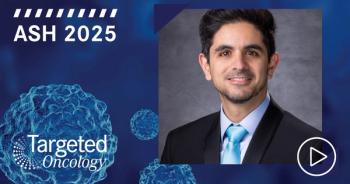
Upfront Immunotherapy Approaches Improve Outcomes in ALL
Recent advancements have improved the way physicians treat acute lymphoblastic leukemia.
Treatments for patients with acute lymphoblastic leukemia (ALL) have produced notable improvements in outcomes in the past few years with the advent of pediatric intensive regimens for adolescents and young adults, use of minimal residual disease (MRD) for risk assessment, and introduction of potent immunotherapeutic agents including blinatumomab (Blincyto), inotuzumab ozogamicin (IO; Besponsa), and chimeric antigen receptor (CAR) T-cell therapies tisagenlecleucel (Kymriah) and brexucabtagene autoleucel (brexu-cel; Tecartus).
The randomized phase 3 TOWER trial (NCT02013167) showed the benefit of blinatumomab vs chemotherapy in patients with relapsed or refractory B-cell acute lymphoblastic leukemia (B-ALL), and the randomized phase 3 INO-VATE trial (NCT01564784) demonstrated the benefit of IO compared with chemotherapy in that same setting.1,2 Blinatumomab has also shown significant benefit in converting patients who are MRD positive to MRD negative at a rate of 80%.3 The phase 2 ELIANA trial (NCT02435849) in pediatric patients and the
These encouraging results have led to significant interest in moving these immunotherapeutic approaches to the frontline setting. At The University of Texas MD Anderson Cancer Center, IO and blinatumomab have been combined with the hyper-CVAD (hyperfractionated cyclophosphamide, vincristine sulfate, doxorubicin hydrochloride, and dexamethasone) and mini–hyper-CVD (mini–hyper-CVD alternating with mini-methotrexate and cytarabine) regimens to achieve a 100% complete remission (CR) rate, a 95% MRD negativity rate, and a 3-year overall survival (OS) rate of 87% with hyper-CVAD plus IO and blinatumomab, and a 90% CR rate, a 94% MRD negativity rate, and a 5-year OS rate of 48% with mini–hyper-CVD plus IO and blinatumomab in patients with
The German Multicenter Study Group for Adult ALL (GMALL) has studied the addition of 3 cycles of IO as induction therapy followed by standard chemotherapy in 43 patients with Ph-negative B-ALL older than 55 years and demonstrated a 100% CR rate, a 74% MRD negativity rate, and a 2-year OS rate of 81%.8
The
Several recently reported phase 2 trials have incorporated blinatumomab into frontline therapy. The phase 2 LAL2317 trial (NCT03367299) used sequential chemotherapy and blinatumomab to improve MRD negativity in adults with Ph-negative B-cell precursor ALL (BCP-ALL). Two cycles of blinatumomab were added to a pediatric-inspired chemotherapy backbone—the first one after consolidation cycle 3 and the second after consolidation cycle 6. The study enrolled 149 patients with a median age of 41 years (range, 18-65). At the end of induction, 88% of patients achieved a CR and 70% achieved MRD negativity, with MRD negativity increasing to 93% after the first cycle of blinatumomab. The disease-free survival (DFS) and OS rates at 3 years were 65% and 71%, respectively.10
The GMALL group reported preliminary results from its phase 2 EWALL-BOLD trial (NCT03480438) in 50 patients with Ph-negative BCP-ALL aged 56 to 76 years. Participants received 1 cycle of chemotherapy, followed by a cycle of blinatumomab and then 3 further cycles of blinatumomab alternating with cycles of age-adapted consolidation chemotherapy. Findings showed that the hematologic CR rate increased from 76% after the first cycle of induction chemotherapy to 85% after the blinatumomab induction cycle and that the molecular CR rate increased from 18% after chemotherapy to 82% after blinatumomab induction. The 3-year OS rate was 67% in the EWALL-BOLD trial compared with 49% in a historical chemotherapy control group (P = .08).11
The single-arm phase 2 HOVON146ALL trial (NCT03541083) enrolled patients with newly diagnosed BCP-ALL aged 18 to 70 years. Treatment utilized a pediatric-inspired protocol but with reduced doses of chemotherapy and asparaginase for patients 40 years and older. In 71 patients with a median age of 53 years, a CR rate of 95% was achieved, with 91% achieving MRD negativity. For patients younger than 40 years, the 4-year OS rate was 86% compared with a historical group at 74%; for patients older than 40 years, the 4-year OS rate was 71% vs 51% for the historical group.12
A US intergroup pilot trial (NCT03739814) led by the Alliance Cooperative Group treated older patients with newly diagnosed CD22-positive B-ALL with IO for 1 to 3 cycles, depending on response. Those without cytoreduction received blinatumomab. Patients who achieved a CR to IO received 2 to 3 more cycles of blinatumomab. Twenty-three patients with a median age of 71 years were treated, and the cumulative CR rate was 97%. With a median follow-up of 22 months, the 1-year event-free survival (EFS) and OS rates were 75% and 84%, respectively.13
The phase 2, single-arm D-ALBA trial (NCT02744768)
At a median follow-up of 18 months, the OS rate was 95% and the DFS rate was 88%.14 Long-term follow-up at a median of 53 months was recently reported and showed DFS and OS rates of 76% and 81%, respectively.15
The University of Texas MD Anderson Cancer Center has combined ponatinib (Iclusig) with blinatumomab (up to 5 cycles) and achieved a CR in 93% of 28 patients. Eighty-seven percent of patients achieved a complete molecular response at any point during the study. The estimated EFS and OS are 95% and 95%, respectively.16 In addition, the United States intergroup is currently conducting a phase 3 randomized trial (NCT04530565) of dasatinib or ponatinib (investigator choice) with hyper-CVAD or blinatumomab in patients aged 18 to 70 years with newly diagnosed Ph-positive ALL. The results are eagerly awaited. In conclusion, the addition of immunotherapeutic agents to frontline therapy of B-ALL has been shown to improve survival in phase 2 and 3 clinical trials. Earlier introduction of these agents into therapy will likely improve outcomes further, and early studies suggest that these agents could likely replace or significantly reduce the use of chemotherapy, lessen toxicity, and improve outcomes. The addition of CAR T-cell therapy in the frontline setting has the potential to enhance responses even further.









































